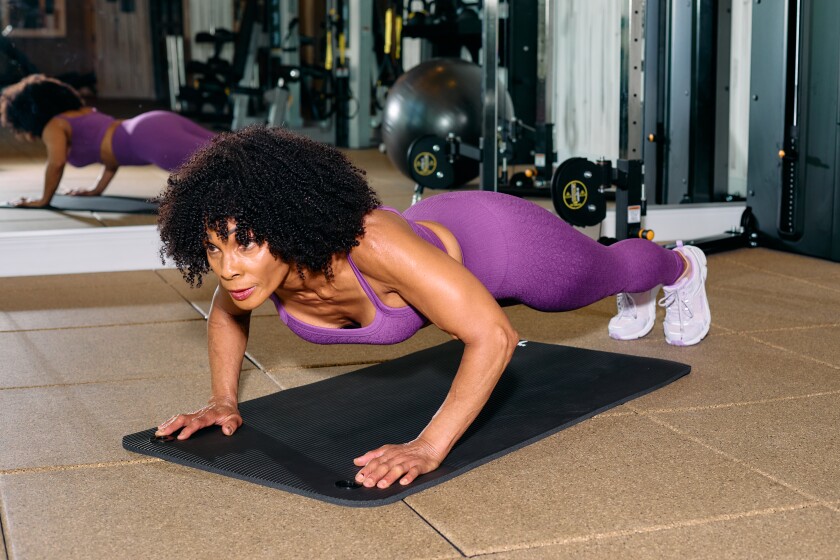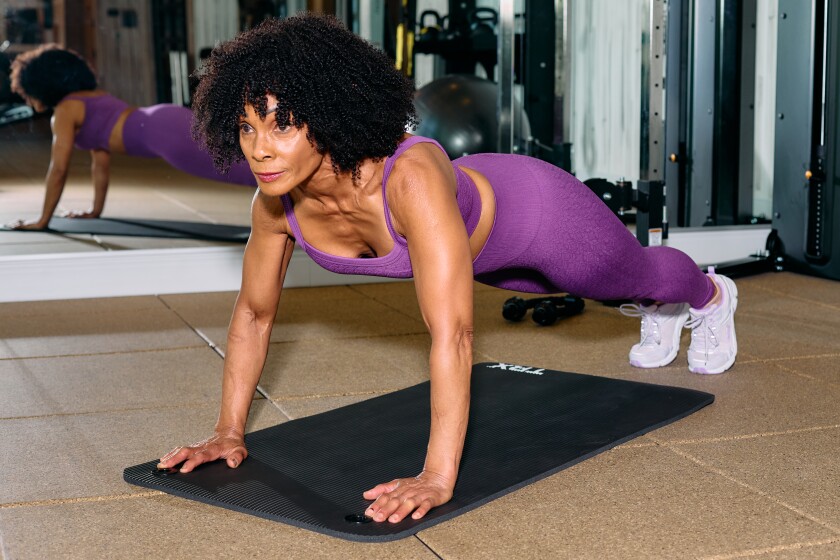If push-ups are a part of your routine, how many can you do comfortably today? Does this article inspire you to "push" a little harder? Share your thoughts in the comments below.
For Chef Babette Davis—the fitness enthusiast reaching more than 315,000 followers on Instagram @chefbabette while serving as co-owner and head chef of Stuff I Eat, a plant-based restaurant in Inglewood, California—being strong is important for her restaurant work and personal goals.
“What’s important to me is strength as a whole,” Davis says. But while she’s strong, and has maintained her toned arms, she finds herself with a bit of movement in what some call the batwing area. And that’s normal. “I’ve got a little shake where most women have a shake,” she tells us. “So, when I’m working with a trainer, I’m constantly working on that area to get that area tighter.”
Like Davis, you may notice a shake or two these days. And there are reasons for this shift. For one, the body naturally changes shape with age, and body fat increases steadily after age 30, the National Library of Medicine confirms. Aging also is associated with an overall loss of muscle volume, including in your upper limbs. And if you lose weight, especially if it happens quickly or if you’re older, you may have saggy skin. In fact, the production of collagen—which provides structure, support, and strength to your body—goes down with age, and existing collagen breaks down faster, Cleveland Clinic confirms. The result of age-related muscle and collagen loss is often that wobbly, wagging action observed above the elbow when one waves hello while wearing a sleeveless outfit. But don’t fret. You can work to lessen this movement, if you want to.
The result of age-related muscle and collagen loss is often that wobbly, wagging action observed above the elbow when one waves hello while wearing a sleeveless outfit.
So, when Davis shared how she’s maintaining her toned arms, and working to keep toning, we had questions. And when we learned she’s doing it through an exercise that requires no weights, and no special equipment, we were intrigued. And because Davis is a wonderful example of what healthy living can make possible as we age, we’re sharing this info with you.
So what’s a key exercise keeping her arms strong and toned? Push-ups. In fact, push-ups use your body weight to work out muscles in the arms, shoulders and chest, as Harvard Health confirms. And, like planks, they can work your core.
Waving goodbye to upper arm flab

But there’s no need to do the most. Davis started slow. “I started with five pushups, and what I decided to do was I wanted to, every day, add a pushup. Every day, if I could,” she explains. “And if I couldn’t add one, I just did however many I did the day before. But I would do push-ups every single day.”
I started with five pushups, and what I decided to do was, every day, add a pushup. And if I couldn’t add one, I just did however many I did the day before. But I would do push-ups every single day.
She eventually wanted to be able to do 72 push-ups for her 72nd birthday. And she surpassed her goal. “I was supposed to be doing 72, my age, but once I got in the 70s, I was like, ‘I might as well just knock this next 20 out and do 100,’” and that’s what I did,” she says. “I started doing sets of 10, but I only gave myself a minute or so between sets.”
Just remember: Her end goal doesn’t need to be your beginning. There can be a push-up style and routine just for you, and everyone starts somewhere.
How to get started—or level up
Before you get low, you may decide to talk with your health care provider, especially if you have health conditions or questions. And know floor push-ups are not the only option.
Then, if you decide to start, make sure you’re warmed up properly, says Tasha Cooper-Ware, CEO and founder of HLS Collective, a healthy lifestyle collective and personal training community, and an NASM-certified personal trainer. “We spend a lot of time sitting on our phones and on computers, and we can get very tight in our chest, so you may want to stretch out your trunk,” she explains.
There is a beginner push-up. There is an intermediate, and advanced, and even a super advanced.
You can do chest stretches using a foam roller, says Cooper-Ware. Or you can stand in an open doorway and raise your arms to the side at 90-degree angles with your palms forward. Then step forward with one foot and hold the stretch for 15 seconds (or as otherwise instructed), according to St. Luke’s Health System.
After warming up, you have options. “Most exercises, they have a progression,” says Cooper-Ware. “There is a beginner push-up. There is an intermediate, and advanced, and even a super advanced,” she adds, with many variations. Eventually, if you can, you can consider doing three sets of 10 to 12 reps, she says.
And when it comes to taking it slow and listening to your body, Davis has advice. “You wind up hurting yourself if you don’t. You just take your time. Just do you,” she says. “Just be so grateful to yourself that you’re getting up and doing something for you, because there is absolutely no one on this planet that can do it for you.”
Now, here’s the scoop on three push-up variations, according to Cooper-Ware.
Beginner Push-Up

You can start on a wall, which can be less challenging and gentler on your joints than floor push-ups. While in a standing position, lean forward and put your hands on a wall about chest-high. (Your form should still look like a floor push-up.) Feel some of your weight supported through your arms and then slowly bend your elbows to bring your chest closer to the wall. Then push back to your starting position.
Intermediate Push-Up

This is the push-up you probably know. Begin in a plank position. Keep your back and legs straight. Bend your elbows and lower yourself to the floor, then push yourself up to your starting position.
Note: You can modify this move by bending your knees, as Davis demonstrates in the photo. But Cooper-Ware says she doesn’t love that version because it can be hard to get your pelvis in the right place. As she explains, you need to activate your glutes, which is hard to do if your knees are bent.
You just take your time. Just be so grateful to yourself that you’re getting up and doing something for you, because there is absolutely no one on this planet that can do it for you.
Advanced Push-Up
If you’ve strengthened your chest and arms, and have no contraindicated conditions or concerns, you might consider a variation that elevates your legs to shift more weight toward the upper body. Instead of getting flat on the floor, incorporate a stable and raised surface into your workout. (You can start with a low surface like a curb, or progress to a workout bench.) To start, kneel down, with your back to the raised surface, and put your hands shoulder-width apart on the floor. Extend one foot at a time onto the structure behind you so you’re in a push-up position. Bend your elbows, keep your back straight, and lower your chest to the floor. You also can engage your core and glutes. Then, push up to your starting position.
Just remember, it’s consistency rather than intensity that will help you get and keep results. Stick with what works for you.
If push-ups are a part of your routine, how many can you do comfortably today? Does this article inspire you to "push" a little harder? Share your thoughts in the comments below.











